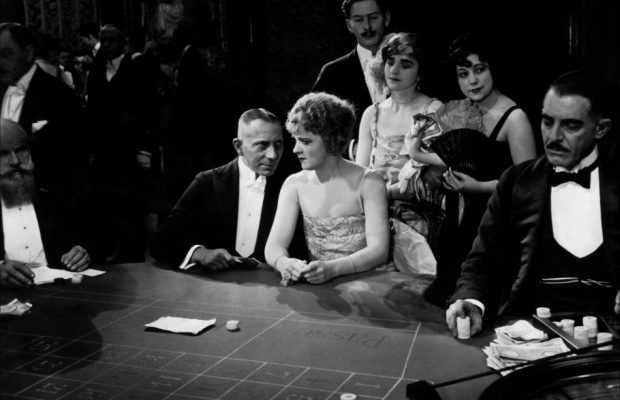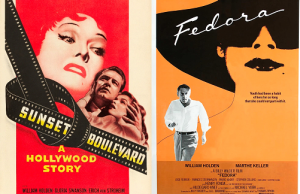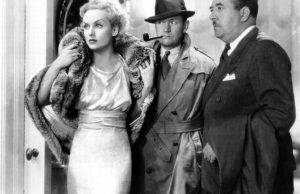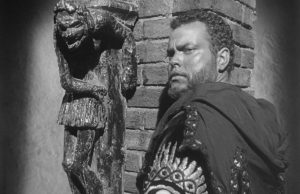Foolish Wives (1922)

Toronto Film Society presented Foolish Wives (1922) on Monday, April 15, 1964 as part of the Season 16 Monday Evening Silent Film Series, Programme 6.
~~~~~~~~~~~~~~~~~~~~~~~~~~~~~~~~~~~~~~~~~~~~~~~~~~~~
Programme No. 6
(Monday, April 13, 1964)
TWO FILMS FROM EARLY 1922
CHARLIE CHAPLIN in Pay Day
ERICH VON STROHEIM in Foolish Wives
~~~~~~~~~~~~~~~~~~~~~~~~~~~~~~~~~~~~~~~~~~~~~~~~~~~~~~~~~~~~~~~~~~~~~~~~~~~~~
Pay Day
Released by First National, April 2, 1922
Produced and directed by Charles Chaplin
Photographed by Rollie Totheroh
Two reels (original length: 1892 feet)
Players: Charles Chaplin; Phyllis Allen
(as the Wife); Mack Swain (as the Foreman);
Edna Purviance (as his daughter); Sydney
Chaplin (as friend and owner of food stand);
Harry Bergman; Allan Garcia.
For notes on Chaplin, see Program No. 2 (Nov 18, 1963), – or better still, read the biography by Theodore Huff, or the one by his son and namesake: “My Father, Charles Chaplin”. (The Sydney Chaplin above was Charlie’s half-brother, of course, not his son. Syd became a popular film star in his own right for awhile, in such films as Charlie’s Aunt and The Better ‘Ole).
Foolish Wives
Produced by Universal Jewel; released February 1922
Direction, story and scenario by Erich von Stroheim
Photography by Ben Reynolds and William Daniels
Settings by Richard Day and Erich von Stroheim
CAST
Count Wladislas Sergius Karamzin…Erich von Stroheim
His “cousins”………………………………..Maude George & Mae Busch
The maid…………………………………….Dale Fuller
The counterfeiter……………………………Cesare Gravina
His daughter…………………………………Malvine Polo
The American Ambassador……………….George Christians
His wife………………………………………Miss (SIC) Dupont
So that our members may be duly warned about the questionable nature of the film they are about to see, we print in its entirety (complete with the original staccato paragraphing) the review in PHOTOPLAY MAGAZINE for March, 1922. It did not appear in the magazine’s regular review section, “The Shadow Stage”, but was given a special boxed page all to itself:
Foolish Wives: A review of a picture that is an insult to every American.
So much publicity has been given this picture, which was released too late to be included among the Shadow Stage reviews, that we feel our readers would like to know what it is all about.
This–the much heralded million-dollar production–has been shown at last, fourteen reels. It is the most eccentric film ever put together. At times startlingly beautiful, at other times repulsively ugly, it is an amazing hodge-podge.
The American public cannot be expected to pay the million dollars that Universal, and Erich von Stroheim, have wasted, not spent.
An unworthy theme, the ugly amours of a pseudo-count from Russia, it has been produced with consummate care and unceasing imagination.
There is no doubt that Mr von Stroheim probably spent almost the press-agented million on his sets and other effects; if he had spent as much time on his story–if he had had a tale worth telling–he would have earned the applause of that Broadway first night audience and every other audience in the world.
As it is, he has made a photoplay that is unfit for the family to see; that is an insult to American ideals and womanhood.
To point a doubtful moral, von Stroheim has adorned a gruesome, morbid, unhealthy tale. That he could give to it his admitted genius for detail and artistic talents is nothing short of incredible.
Portraits such as Griffith himself never dreamed of. Beautiful bits of acting. Monte Carlo, as real as itself. Photography and decoration of unsurpassed appeal. And an insight into continental morals and manners such as only, so far, we have been able to get from certain books and paintings.
All wasted, on a story you could never permit children or even adolescents to see. A story that sickens before you have seen it half told. Your verdict is ready before the end.
Absurdities and atrocious melodrama; astounding subtleties and keen beauty–a beautiful waste.
Von Stroheim wrote the story. It is, as we have said, morbid; more, it is unreal. He has lifted one of his most effective episodes right out of Frank Norris’s masterpiece, “McTeague”. At other times, he is almost original. He never knows when to let a scene alone; he whips it into insensibility before he lets it go. Consequently, every sequence is twice too long.
This picture, which has been advertised, actually, as a “one-hundred percent American” enterprise, is an insult to every American in the audience. Consider: an American, of sufficient prestige and importance to be selected by the President of the United States as a special envoy in charge of a vitally important mission to the Prince of Monaco, is depicted as a man who does not know how to enter a room or wear formal dress.
His wife is represented as the type of woman who strikes up a terrace flirtation with a Russian count who accepts money from a serving maid! To say nothing of the continual innuendoes as to American ideals; the little sly thrusts at our traditions and our sentiments.
The actors are all good. Rudolph (SIC) Christians is excellent; Miss Dupont pretty and perfumed and exceedingly commonplace as the Foolish Wife–there is only one of them. Mae Busch is sparkling and would have been more if she had had an opportunity; Maude George makes the most of her role; she has it–the talent and the temperament; Dale Fuller is exceedingly good. Von Stroheim, who is a competent actor at all times, projects himself into too many scenes.
He has abused his directorial privileges.
It is not artistically great.
It is really nothing.
(PHOTOPLAY; March 1922; p.70)
Notice the reference to “fourteen” reels. The present print is in eight reels (or wuld be if it were in 35mm instead of 16mm). Eveidently Foolish Wives did intially reach the screen in the original three-hour version that Stroheim intended, before Irving Thalberg (then a senior executive with Universal) ordered it edited down for general release. (One source, however, says that the reduction was from 21 reels to 14; and if that is correct, then our print is an even more drastic reduction. But 21 reels at “silent” speed would have made it run over five hours, and the same writer refers to this version as “three hours”. I could be wrong, but I have a suspicion this writer has arrived at his figures by translating from hours to reels and has forgotten to make allowance for the difference between “silent” and present-day “sound” speeds).
If the Photoplay reviewer is right in protesting that “every sequence is twice too long”, this drastic trimming may well have improved the film. However, it has also been said that several scenes were deleted at the instigation of the Federation of Women of America. Whether the “unseemly abruptness” of the ending is due to this, or to the Thalberg editing, or to chance incompleteness in the only surviving print, we cannot tell you. And since these notes are being written before I have seen the film, I am unable to report whether or not the print retains the change ordered by the F.W.A.: the transformation of the American Ambassador into a travelling salesman! (Which, as Stroheim has pointed out, “of course weakens the story, because Count Sergius in the film used the wife of the American Ambassador to put the counterfeit money into circulation. Nobody would have ever believed that the Ambassador’s wife would ever do such a thing, whereas the wife of a commercial traveller would have been immediately suspect. Thus, the point I made of selecting as a medium for the distribution of the counterfeit money a person of unquestionable integrity, was lost”.)
Before we leave the Photoplay review, notice the claim that Stroheim “lifted” one of the episodes from Frank Norris’s “McTeague”:. It may well be true. Three years later Stroheim filmed the whole of that book as Greed.
Hollywood has finally caught up with Stroheim’s inordinate passion for making oversized movies; but in the 1920’s, only a dozen or so years away from the days when all movies were one-reelers, this was not to be tolerated, and time after time Stroheim’s films would be taken away from him to be finished, or at least edited down to reasonable length, by someone else. Added to his passion for accurate detail, which, in addition to such praiseworthy results as the accurate replicas of the Café de Paris and other famous Monte Carlo landmarks in Foolish Wives, also led him to such dubious actions as having real electric wiring installed in every room of a studio-reproduced hotel, and the embroidering of the royal crest on the extras’ unseen underwear, Stroheim’s reputation for unrealistic and high-handed extravagance gradually overshadowed his value to producers, and eventually wore out his welcome, Gloria Swanson being about the last to give him a try in the ll-fated Queen Kelly (1928). (Four years later, Fox did give him another chance, but after 32 reels, Walking Down Broadway was shelved, then almost entirely refilmed and released in 1933 as Hello Sister).
That he was still in demand as late as 1928 is an indication both of his continued high prestige and of the more effective fact that his films usually made money. Even Greed, popular legend to the contrary, made a slight profit. As for his first film Blind Husbands (1919), it had made so much that it resuced Universal from impending bankruptcy.
Erich von Stroheim was born in Vienna in 1885. His father was Colonel of the Dragoons and his mother was a lday-in-waiting to the Empress Elizabeth, and his early years were spent in a military academy and in the Austrian court. He was for a time in the army and in the Palace Guard; but evidently he decided this was not to be his future, and in 1909 he emigrated to the United States, where he supported himself at various jobs, menial or otherwise, till we find him in Hollywood in 1914, working as an extra. D.W. Griffith hired him to play six negro roles in The Birth of a Nation (not all in the same scene presumably) and before the picture was finished he was one of the assistant directors. As both actor and assistant director he worked with Griffith for four years, and to the end of his life Stroheim continued to acknowledge his admiration for and indebtedness to Griffith. Meanwhile, the first World War “was a bonanza to him because, though Austrian to the core, he could play Prussian officers to the life. To millions of Americans he became ‘the man you love to hate’, the very image of the hideous Hun.
“When the war ended there seemed little future for him. Somehow he persuaded Carl Laemmle to permit him to star in and direct his own story, Blind Husbands, 1919. It was at once apparent that an important talent had arrived. Stroheim’s handling of his actors, his camera placement and cutting derived from Girffith, but here was an insistence and intensity which bespoke an individual vision of the world. That vision was certainly a novelty to movie audiences. They were familiar enough with the wickedness of Paris, the desperations of Monte Carlo, and the infidelities of Alt Wien as routinely portrayed by Hollywood, but Stroheim’s versions of these worlds had a detailed, firsthand intimacy which carried new conviction. His films portrayed successively the prewar world dancing heedlessly on the volcano; the blindness and confusion of wartime society; and finally, pleasure-mad postwar Europe in full disintegration”. (The foregoing has been “lifted” from “The Movies” by R. Griffith and A. Mayer).
Universal made so much profit on Stroheim’s first two films that he was given a free hand for the making of his third, Foolish Wives; and the publicity department capitalized on its mounting production costs by proudly announcing them on a huge electric sign on the corner of Broadway and 44th Street, the figures being brought up to date once a week with elaborate ceremony. In actual fact, the expenses were greatly exaggerated to make it look impressive, with the final result that the publicity backfired, tending to alienate the public rather than attract it. It was fortunate for Universal that the film cost much less than the “press-agented million”, for it grossed only $800,000. However, in his fourth film, The Merry-Go-Round, things got so out of hand that the no-nonsense Thalberg finally pulled Stroheim off the job and had it finished by another director.
Even History of Films contains several pages devoted to Erich von Stroheim and his merits (or otherwise; the controversy is still heated) as a director; but it is not as a director but as an actor that he is being represented on this year’s Silent Series, so we shall avoid further discussion of this admittedly more important aspect of his career, dismissing the subject with a bare listing of the tiles of his films. For Universal he made Blind Husbands (1919), The Devil’s Passkey (1920), Foolish Wives (filmed in 1921) and The Merry-Go-Round (1923). For MGM: Greed (1924) and The Merry Widow (1925). For Paramount: The Wedding March (1928); for United Artists (Gloria Swanson): Queen Kelly (1928; never released in North America); and for Fox: Walking Down Broadway (1932; never released).
(Before completely dropping the subject, we should also refer you to Patrick Dennis’s amusing novel about an eccentric film director, “Genius:m which was clearly inspired by, though certainly not modeled on, the career of Erich von Stroheim).
As an actor, Stroheim in his heyday as a star has probably nowhere been better described than by S.J. Perelman in an article to be found in “The Most of S.J. Perelman”, which we hereby quote:
CLOUDLAND REVISITED: VINTAGE SWINE
Some Hollywood flack, in a burst of inspiration, dubbed him ‘The Man You Love to Hate’. He was a short man, almost squat, with a vulpine smirk that told you, the moment his image flashed upon the screen, that no wife or bankroll must be left unguarded. The clean-shaven bullet head, the glittering monocle, and the ramrod back (ketp rigid by a corset, it was whispered) were as familiar and as dear to the movie-going public as the Pickford curls. No matter what the background of the picture–an English drawing room, a compartment on the Orient Express, the Legation Quarter of Peiping–he always wore tight-fitting military tunics, flaunted an ivory cigarette holder, and kissed ladies’ hands profusely, betraying them in the next breath with utter impartiality. He was the ace of cads, a man without a single redeeming feature, the embodiment of Prussian Junkerism, and the greatest heavy of the silent film, and his name, of course, was Erich von Stroheim.
When von Stroheim set out to limn a louse, he put his back into it. He never palliated his villainy, never helped old ladies across the street to show that he was a sweet kid “au fond” or prated about his Oedipus complex like the Percy boys who portray heavies today. I remember Grover Jones, a scenarist of long experience, once coaching me in Hollywood in the proper method of characterizing the menace in a horse opera. “The minute he pulls in on the Overland Stage”, expounded Jones, “he should dismount and kick the nearest dog”. Von Stroheim not only kicked the dog; he kicked the owner and the S.P.C.A. for good measure.
The picture that canonized von Stroheim for me was Foolish Wives, a gripping expose of the swindlers who were popularly supposed to prey on rich Americans in Monte Carlo. In this 1921 chef-d’oeuvre, he impersonated a spurious Russian noble named Wladislas Sergius Karamzin, as ornery a skunk as ever flicked a riding crop against a boot. Everything about him seemed to me touched with enchantment: his stiff-necked swagger, his cynical contempt for the women he misused, and, above all, his dandyism–the monogrammed cigarettes, the dressing gowns with silk lapels, the musk he sprayed himself with to heighten his allure. For six months afterwards, I exhibited a maddening tendency to click my heels and murmur “Bitte?”, along with a twitch as though a monocle were screwed into my eye. The mannerisms finally abated, but not until the Dean of Brown University had taken me aside and confided that if I wanted to transfer to Heidelberg, the faculty would not stand in my way.
After Foolish Wives Stroheim appeared in only one of his films: The Wedding March; but when he was forced to abandon his megaphone, he resumed his career as an actor and made a precarious living in other men’s films. Among them was The Great Gabbo (1929), Three Faces East (1930), Friends and Lovers (1931), The Lost Squadron (1932), As You Desire Me (with Greta Garbo) (1932), The Crime of Dr Crespi (1935) and The Devil Doll (1936). Then Jean Renoir brought him to France for La Grande Illusion (1938) in one of the best roles he ever had. His comeback in France seemed asured, buthe had barely signed to direct a new film when the War broke out. He found himself back in Hollywood playing hideous Huns all over again: I Was an Adventuress (1940), Four Graves to Cairo (1943) in which he played Rommel, and North Star (1943). After the war he returned to Euroope and was active in films there. His most memorable post-war Hollywood appearance was as the ex-film director in Sunset Boulevard (in which footage from Queen Kelly was used to represent the film he had directed for the ex-film star played by Gloria Swanson,–a piece of authentic realism that ex-director Stroheim must have appreciated!) He also wrote a novel called “Paprika”. He died of cancer on May 12, 1957, at the age of 71, at his home just outside Paris.
Notes by Fraser Macdonald
ERRATA
(1) May 16 programme notes: George Patterson points out that Only Angels Have Wings was not Richard Barthelmess’s last screen appearance. He had small roles in three more films: The Man Who Talked Too Much (1940), The Mayor of 44th Street (1942) and his 76th and last film, The Spoilers (1942).
(2) Feb 10. William Everson conveys his objection to our assigning Shoot’ Mad to 1911; he says it’s 1918, which would indeed account for its surprising technical superiority. The latest MMA catalogue likewise says 1918, which is presumably a correction of its previous catalogues which had said “c1911”. We took the earlier date because it seemed more consistent with the biographical data on Anderson.
(3) Future archivists please note that Programme No 3 occurred Jan 13, 1964, not 1963.
HAVE A GOOD SUMMER – SEE YOU NEXT FALL!
~~~~~~~~~~~~~~~~~~~~~~~~~~~~~~~~~~~~~~~~~~~~~~~~~~~~~~~~~~~~~~~~~~~~~~~~~~~~~
QUESTIONAIRE
(We’d like you to fill this out and hand it in to us before you leave tonight; but if you’d rather wait and think it over, you may either hand it in at the door at the next programme of the TFS Main Series, or else mail it to Fraser Macdonald, 110 Maitland St (Apt 106, Toronto 5).
TFS Silent Series 1963-64:
FEATURES
Oct 28, 1963 A Fool There Was (Theda Bara)
.
.
Nov 18, 1963 Blood and Sand (Valentino)
Jan 13, 1964 The Thief of Bagdad (Fairbanks)
Feb 10, 1964 The Dancin’ Fool (Wallace Reid)
.
Mar 16, 1964 Way Down East (Lillian Gish)
Apr 13, 1964 Foolish Wives (Stroheim)
SHORTS
A Corner in Wheat
The New York Hat (Mary Pickford)
Barney Oldfield’s Race for Life
Burlesque on Carmen (Chaplin)
…..
Shootin’ Mad (Broncho Billy)
Enoch Arden (excerpt)
At the Crossroads of Life
Pay Day (Chaplin)
~~~~~~~~~~~~~~~~~~~~~~~~~~~~~~~~~~~~~~~~~~~~~~~~~~~~~~~~~~~~~~~~~~~~~~~~~~~~~
NOTE: On the above list, please cross out the ones you missed.
(1) Which programme (taken as a whole) did you enjoy most?
(2) Which of this year’s features would you give the Oscar to?
(3) Which short(s) did you like best?
(4) Are there any of the above films you would look forward to seeing again?
(5) Which performances would receive your Oscars?
(6) Which of the stars featured in this year’s series would you look forward to seeing in other films?
(7) What are some of the other silent film stars yo would like to see?
(8) What films of the silent period would you particularly like to see:
(a)…that you have seen before:
(b)…that you have not seen before:
(9) Have you any other comments to make on this year’s season, or any suggestions to offer for future seasons? (Write on the back if you wish)
IMPORTANT NOTICE: The above questionaire is in the nature of a public opinion poll rather than a genuine democratic plebiscite. The films actually available to us are very limited in number, and we just can’t present everything we’d like to. But wishes are cheap, and we’d enjoy hearing what yours are even if we can’t do anything about it,–and who knows, maybe it will turn out that we can!
















Leave a Reply